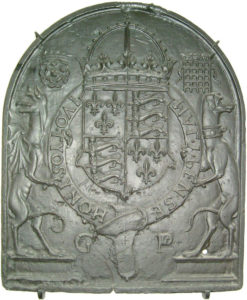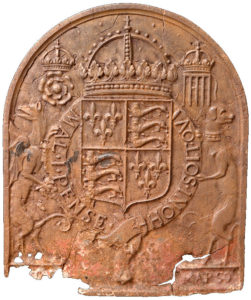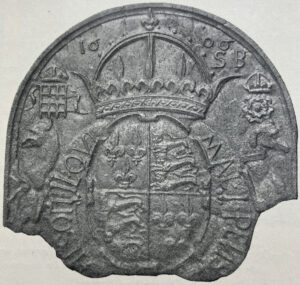

Hans Schubert wrote the above note in 1953 when he was researching for his history of the British iron and steel industry. In it he made clear that he regarded the fireback of 1548 as the earliest dated fireback made in England. However, his own evidence of the examples in continental museums – the one he illustrates is in Düsseldorf – strongly suggests that, despite an example being in the late-medieval house of Ockwells near Maidenhead, this is not an English fireback. I have already set out the reasons for this in the Introduction to this website, but Schubert’s observation that an example formerly at Libramont in Belgium, and illustrated in Henri Carpentier’s great catalogue of French firebacks, Plaques de Cheminées, differed slightly from the one he illustrated has prompted me to put forward some other variations of the same basic design which, while very similar, differ in small degrees.


Schubert mentioned a fragment in the collection at Anne of Cleves House in Lewes, East Sussex, shown here on the left. Close examination reveals several differences: the crown over the rose in the top left corner is not the same, nor is the rose itself; the portcullis in the top right corner is in a different position; the head of the greyhound, the supporter to the right of the shield, is at a higher angle than on Schubert’s example; and, most curiously, the inscription on the Garter is arranged in the opposite direction – rotating anti-clockwise on Schubert’s and read from the outside, but clockwise and read from the inside on the Lewes casting. This can be seen more clearly on a largely complete example of the same design in a private collection at Consuegra, south-east of Toledo in Spain, shown above on the right.

There is a similar fireback in the Victoria and Albert Museum, in London. Again there are minor differences in the proportions and in the form of the decorative elements, notably the crown which this time has a circlet of stylised fleurs-de-lys instead of acanthus leaves, the use of coronets instead of crowns over the rose and portcullis, and the shield which has a more elaborate outline. But the Garter motto, this time, while still written clockwise, has to be read backwards and from the outside! Whoever carved the pattern clearly did not realise that the image on the pattern will be the same as on the finished casting, and that only in the mould is the image reversed; the craftsman also reversed the letter ‘N’ in both instances.

The same reversed Garter motto can be seen on a fireback of almost the same design that appeared at auction in Paris in 2023. Once more there are minor differences in the proportions and in the positions and forms of the coronets over the rose and the portcullis, and in the outline of the shield (even more elaborate on this design). Like most of the other firebacks illustrated, the detail of the casting, and therefore of the original pattern, is of exceptional quality.

Apart from the Libramont casting illustrated by Carpentier, which is effectively the same as the ones in Düsseldorf and at Ockwells but without the extended ‘shoulders’, this example, the location for which I have no information, shares many of the features seen on them. It is not the same casting though because, again, there are several minor differences to the proportions of the crowns (not coronets this time) and to the supporters. The motto is in a sensible orientation and the shield outline is plain.

Finally, Henri Carpentier illustrated this fragment, from the museum in Metz in Alsace, in his book Plaques de Cheminées of 1912. This time the shield is oval, the motto is written backwards from the outside, like the V&A casting, and the positions of the crowned rose and portcullis are reversed. Carpentier interpreted the last of these as the portcullis of the Tudors and the rose of the Stuarts, whereas both were badges of Henry VII. Above the circlet of the crown over the shield are fleurs-de-lys. In what is clearly an addition to the original pattern, the inappropriate date of 1606 (i.e. in the reign of the Stuart King James VI and I) has been inserted above the crown, and the initials, SB, which could be those of the founder, the pattern-maker or the person for whom the fireback was made, squeezed in to the right of the crown. Like all the others it is arched-shaped.
The style of the execution of the patterns from which these various firebacks were made is so similar that there is a strong probability that they were all the work of the same individual, perhaps fulfilling orders from different ironworks for a pattern depicting the Tudor royal arms of England. But why the differences in the Garter mottoes? The two fireback designs that have the reversed inscription are also the ones that have the more elaborate shield shapes. The Paris casting also has a partial date, which was probably 1570 before the 7 was damaged. However, this may not have been the date of the original pattern as it would have been easy enough to add a date to the mould before casting. There is also a faint date on the Consuegra casting, possibly a 28 in the bottom right corner, suggesting 1528. Two of the castings have initials, GC and GP respectively. Were these the initials of the pattern-maker? If so it negates the supposition that they were all the work of the same person. Or were they added to the moulds before casting to identify the founder or the person for whom the fireback was being made?
At the beginning of this note and in my Introduction to British Firebacks I argued that these were not English firebacks, citing the styles of the crowns and of the supporters in particular. Simple arched firebacks are most frequently encountered in the products of the ironworks in the Spanish Netherlands, in what is now southern Belgium and Luxembourg and the adjacent parts of modern Germany and France, and the connections between Spain and England, through the marriages of Henry VIII and Catherine of Aragon, and later of Queen Mary I and Philip II of Spain, offer a possible motive for the production of these designs. The portrayal of the dragon and greyhound supporters links these firebacks to the earlier of those two alliances, both Henry VIII and his father having them on their achievements of arms. But these castings could, instead, have been designed and made for export to England by continental ironmasters, the importation of 230 firebacks to London from Antwerp in June 1567 being previously noted.